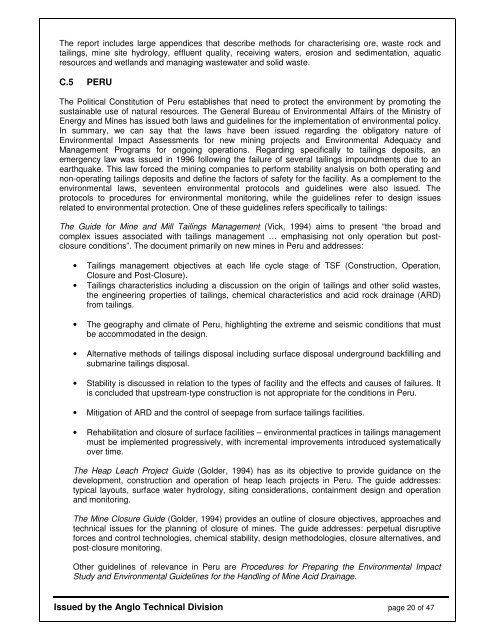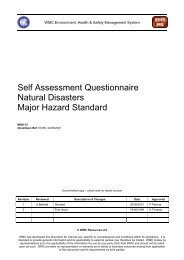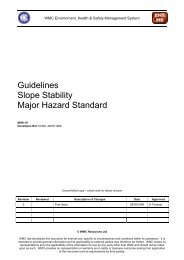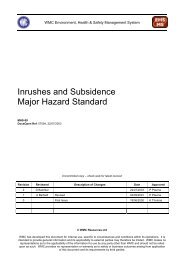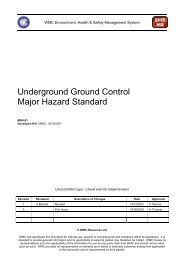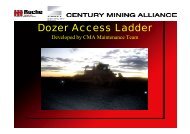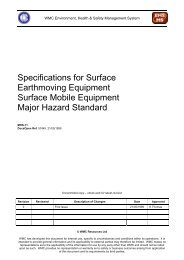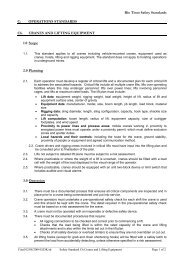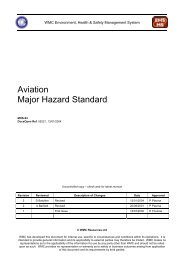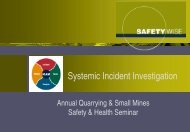SAFETY, HEALTH & ENVIRONMENT BULLETIN - MIRMgate
SAFETY, HEALTH & ENVIRONMENT BULLETIN - MIRMgate
SAFETY, HEALTH & ENVIRONMENT BULLETIN - MIRMgate
You also want an ePaper? Increase the reach of your titles
YUMPU automatically turns print PDFs into web optimized ePapers that Google loves.
The report includes large appendices that describe methods for characterising ore, waste rock and<br />
tailings, mine site hydrology, effluent quality, receiving waters, erosion and sedimentation, aquatic<br />
resources and wetlands and managing wastewater and solid waste.<br />
C.5 PERU<br />
The Political Constitution of Peru establishes that need to protect the environment by promoting the<br />
sustainable use of natural resources. The General Bureau of Environmental Affairs of the Ministry of<br />
Energy and Mines has issued both laws and guidelines for the implementation of environmental policy.<br />
In summary, we can say that the laws have been issued regarding the obligatory nature of<br />
Environmental Impact Assessments for new mining projects and Environmental Adequacy and<br />
Management Programs for ongoing operations. Regarding specifically to tailings deposits, an<br />
emergency law was issued in 1996 following the failure of several tailings impoundments due to an<br />
earthquake. This law forced the mining companies to perform stability analysis on both operating and<br />
non-operating tailings deposits and define the factors of safety for the facility. As a complement to the<br />
environmental laws, seventeen environmental protocols and guidelines were also issued. The<br />
protocols to procedures for environmental monitoring, while the guidelines refer to design issues<br />
related to environmental protection. One of these guidelines refers specifically to tailings:<br />
The Guide for Mine and Mill Tailings Management (Vick, 1994) aims to present “the broad and<br />
complex issues associated with tailings management … emphasising not only operation but postclosure<br />
conditions”. The document primarily on new mines in Peru and addresses:<br />
• Tailings management objectives at each life cycle stage of TSF (Construction, Operation,<br />
Closure and Post-Closure).<br />
• Tailings characteristics including a discussion on the origin of tailings and other solid wastes,<br />
the engineering properties of tailings, chemical characteristics and acid rock drainage (ARD)<br />
from tailings.<br />
• The geography and climate of Peru, highlighting the extreme and seismic conditions that must<br />
be accommodated in the design.<br />
• Alternative methods of tailings disposal including surface disposal underground backfilling and<br />
submarine tailings disposal.<br />
• Stability is discussed in relation to the types of facility and the effects and causes of failures. It<br />
is concluded that upstream-type construction is not appropriate for the conditions in Peru.<br />
• Mitigation of ARD and the control of seepage from surface tailings facilities.<br />
• Rehabilitation and closure of surface facilities – environmental practices in tailings management<br />
must be implemented progressively, with incremental improvements introduced systematically<br />
over time.<br />
The Heap Leach Project Guide (Golder, 1994) has as its objective to provide guidance on the<br />
development, construction and operation of heap leach projects in Peru. The guide addresses:<br />
typical layouts, surface water hydrology, siting considerations, containment design and operation<br />
and monitoring.<br />
The Mine Closure Guide (Golder, 1994) provides an outline of closure objectives, approaches and<br />
technical issues for the planning of closure of mines. The guide addresses: perpetual disruptive<br />
forces and control technologies, chemical stability, design methodologies, closure alternatives, and<br />
post-closure monitoring.<br />
Other guidelines of relevance in Peru are Procedures for Preparing the Environmental Impact<br />
Study and Environmental Guidelines for the Handling of Mine Acid Drainage.<br />
Issued by the Anglo Technical Division page 20 of 47


